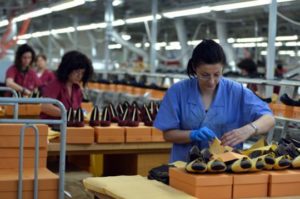A slow recovery characterises the Italian footwear manufacturing industry: the survey conducted by Assocalzaturifici for the first nine months of 2017 on a large sample of businesses belonging to the footwear manufacturing industry outlines a scenario of  stability that is characterised, however, by a good dose of caution. Although all the indicators are positive – starting with production, which has grown on average by 0.7% in volume and 2.1% in value – the sector’s recovery struggles to get underway, especially in light of 2017’s third quarter results, “with volumes more or less unvaried, a slowdown in exports and the domestic demand once again stagnant”.
stability that is characterised, however, by a good dose of caution. Although all the indicators are positive – starting with production, which has grown on average by 0.7% in volume and 2.1% in value – the sector’s recovery struggles to get underway, especially in light of 2017’s third quarter results, “with volumes more or less unvaried, a slowdown in exports and the domestic demand once again stagnant”.
“We are starting to make progress at the end of a year where, after a long period of unsatisfactory results, the first few timid  signals of a market reversal are making themselves known – was the comment of Annarita Pilotti, President of the Association. – However, we cannot allow ourselves to be swayed by false expectations: there are still many businesses in great difficulty”.
signals of a market reversal are making themselves known – was the comment of Annarita Pilotti, President of the Association. – However, we cannot allow ourselves to be swayed by false expectations: there are still many businesses in great difficulty”.
As always, the stability of the sector is due above all to exports which, during the first nine months of 2017, rose by 2.2% in value and by 1.4% in quantity (source: ISTAT). Generally, in EU markets, Made in Italy’s results are stable (+1% in value and +0.2% in volume), reconfirming a slight recovery in France (+0.8% in volume), while experiencing a drop in Germany (-2.9% in quantity, notwithstanding the rise in value by +0.6%).
The performance of non-EU markets is much more dynamic (+4.4% in quantity and +3.6% in value). Reassuring signals of recovery arrive from Russia (with its +28.3% in volume and +18.4% in value), while the Ukraine and Kazakhstan fall back, recording respectively a modest +0.9% rise and -0.4% drop in quantity.
In North America, the USA experiences an improvement in its demand (but only in quantity: up more than +6%), while in Canada the negative downtrend persists (-5.4%): only after the fourth quarter results are in, will it be possible to verify if the temporary entry into force of the CETA free trade agreement will be a positive turning point.
 Instead, in the Middle East, a recovery has been set off (+3.2% in volume), while the Far East experiences a slowdown (-6.8% in volume and -4% in value): the positive performances recorded in South Korea (+7.6% in quantity) and China (+5.5% in quantity, but with a fall in value equal to -1.7%), are unable to compensate for the -12% loss in volume experienced by Japan and Hong Kong.
Instead, in the Middle East, a recovery has been set off (+3.2% in volume), while the Far East experiences a slowdown (-6.8% in volume and -4% in value): the positive performances recorded in South Korea (+7.6% in quantity) and China (+5.5% in quantity, but with a fall in value equal to -1.7%), are unable to compensate for the -12% loss in volume experienced by Japan and Hong Kong.
As demonstrated by the data regarding exports, the positive performance of Made in Italy was reinforced by the efforts of businesses to keep costs to a minimum: the rise in value, in fact, is quite inferior to the rise in volume, as a result of the average price going up by only +0.8% (between 2011 and  2016, instead, the rise in the average price was quite significant at +32%), with a conservative trend or even a downward trend in many important markets, including Russia, where there is a significant -7.8% drop.
2016, instead, the rise in the average price was quite significant at +32%), with a conservative trend or even a downward trend in many important markets, including Russia, where there is a significant -7.8% drop.
The effect of these dynamics in combination with the simultaneous slowdown in imports (-1.6% in value and -3.3% in quantity), allows the sector to record a favourable trade balance of 2.97 billion euros (+6.8% over the same period in 2016), thus reconfirming the important contribution of the Italian footwear manufacturing industry to the national trade balance.
In the domestic market, the demand is still weak (+0.4% in value and -0.3% in quantity) and the only rewarding segment is represented by sneakers, which is on the rise by 4%.
The briefing of Assocalzaturifici ends with a demographic picture of active businesses and employees in the sector: although 99 companies went out of business, employment numbers in the sector went up by an additional 279 workers.




